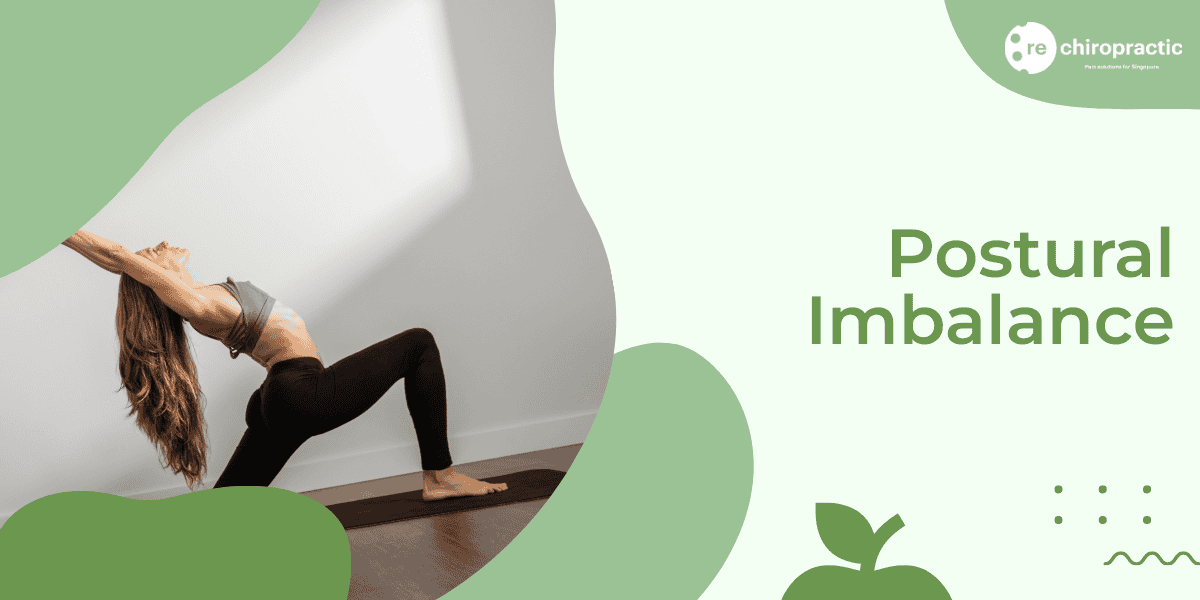
Postural Imbalance
Postural imbalance, also known as postural misalignment or postural dysfunction, refers to an abnormal alignment of the body’s musculoskeletal system. It occurs when there is an imbalance in the positioning of the bones, muscles, and joints, leading to an altered posture. This condition can affect individuals of all ages and can have a significant impact on their overall well-being.
Symptoms & Different Stages of Postural Imbalance
Postural imbalance can lead to various symptoms and discomfort. It is important to understand the symptoms and different stages of this condition in order to identify it early and seek appropriate treatment. Here are some common signs and stages of postural imbalance:
- Mild Stage: In the initial stage, individuals may experience occasional muscle soreness or stiffness, especially in the neck, shoulders, and lower back. They may also notice a slight slouching posture or uneven distribution of weight when standing.
- Moderate Stage: As postural imbalance progresses, individuals may develop more noticeable symptoms. This can include chronic muscle tension, frequent headaches, and difficulty maintaining proper posture. They may also experience pain or discomfort in the joints, such as the knees or hips.
- Severe Stage: If left untreated, postural imbalance can worsen and lead to severe symptoms. At this stage, individuals may experience chronic pain in multiple areas of the body, including the spine, shoulders, and hips. They may also have difficulty performing everyday activities due to limited mobility and decreased flexibility.
It is important to note that the severity of symptoms can vary from person to person, and some individuals may progress through these stages at a faster rate. Additionally, certain factors such as age, occupation, and lifestyle choices can influence the progression of postural imbalance.
If you are experiencing any of the above symptoms or suspect that you may have postural imbalance, it is advisable to consult with a healthcare professional, such as a chiropractor. They can assess your condition, provide a proper diagnosis, and recommend a personalized treatment plan to address your specific needs.
Remember, early detection and intervention are key to preventing further complications and improving your overall well-being. So, don’t hesitate to seek professional help if you suspect that your postural alignment may be compromised.
Most Common Causes of Postural Imbalance
Postural imbalance can be caused by various factors, including:
- Poor posture: Maintaining improper posture for extended periods can gradually lead to postural imbalance. Slouching, hunching over electronic devices, or sitting in a chair with inadequate back support can all contribute to this condition.
- Sedentary lifestyle: Leading a sedentary lifestyle, characterized by prolonged periods of sitting or inactivity, can weaken the muscles that support proper posture. Weak muscles are more prone to postural imbalances.
- Muscle imbalances: Imbalances in the muscles that support the spine and other body parts can also contribute to postural imbalance. When certain muscles are overactive or tight while others are weak or underactive, it can disrupt the body’s natural alignment.
- Injury or trauma: Accidents, falls, or other traumatic events can cause structural damage to the body, leading to postural imbalances. Injuries to the spine, joints, or muscles can alter the body’s alignment and result in postural issues.
- Weak core muscles: The core muscles, including the abdominal and back muscles, play a crucial role in maintaining proper posture. Weakness in these muscles can lead to postural imbalances.
- Uneven leg length: Having one leg shorter than the other, even by a small margin, can cause postural imbalances. The body compensates for the difference in leg length by adjusting the alignment of the hips and spine, which can lead to postural issues.
It is important to note that these are the most common causes of postural imbalance, but individual cases may vary. Identifying the underlying cause of your postural imbalance is essential for effective treatment and prevention of future issues.
How Bad Can Postural Imbalance Get?
Postural imbalance, if left untreated, can have a significant impact on an individual’s overall health and well-being. As the condition progresses, it can lead to more severe symptoms and complications. Here are some potential consequences of allowing postural imbalance to worsen:
- Chronic pain: Without intervention, postural imbalance can result in chronic pain that affects various parts of the body, including the neck, shoulders, back, and hips. This pain can become debilitating, making it challenging to perform daily activities and impacting one’s quality of life.
- Muscle imbalances: As postural imbalance worsens, certain muscles become overused and tight, while others become weak and underused. These imbalances can lead to further postural issues and increase the risk of injuries.
- Joint dysfunction: The misalignment of the spine and other joints caused by postural imbalance can result in joint dysfunction. This dysfunction can lead to reduced range of motion, stiffness, and discomfort in the affected joints.
- Nerve compression: As postural imbalance progresses, it can put pressure on nerves, leading to nerve compression. This compression can cause symptoms such as numbness, tingling, and weakness in the affected areas.
- Impaired organ function: Poor posture can also impact the functioning of internal organs. When the spine is misaligned, it can interfere with nerve signals that control organ function, potentially leading to digestive issues, respiratory problems, and other systemic complications.
It is crucial to address postural imbalance early on to prevent these potential complications. Seeking chiropractic care can help correct postural imbalances, alleviate symptoms, and improve overall spinal alignment. Additionally, incorporating self-relief methods and maintaining good posture can further support the treatment process and prevent the condition from worsening.
Chiropractic for Postural Imbalance
Chiropractic care offers a holistic approach to addressing postural imbalance, focusing on the underlying causes rather than just the symptoms. By utilizing various techniques and therapies, chiropractors can help patients regain proper alignment, improve posture, and alleviate pain associated with postural imbalance. Here are some ways in which chiropractic can help:
- Spinal adjustments: Chiropractors are trained in performing spinal adjustments, which involve applying controlled force to specific areas of the spine. These adjustments help restore proper alignment, relieve pressure on nerves, and improve overall posture.
- Soft tissue therapy: Chiropractors may also use soft tissue techniques such as massage, myofascial release, and stretching to address muscle imbalances and tightness. By releasing tension and promoting flexibility, these therapies can help improve posture and reduce pain.
- Postural exercises: Chiropractors can prescribe specific exercises and stretches to strengthen weak muscles and improve posture. These exercises target the core, back, and neck muscles, helping to restore balance and alignment.
- Ergonomic advice: Chiropractors can provide guidance on proper ergonomics, including correct sitting and standing posture, as well as recommendations for supportive pillows, chairs, and mattresses. Making simple adjustments to daily habits and workstations can greatly contribute to postural improvement.
- Lifestyle modifications: Chiropractors may also suggest lifestyle changes to support postural health. This may include recommendations for regular exercise, weight management, stress reduction techniques, and adopting healthy habits like taking breaks from prolonged sitting or standing.
It is important to note that chiropractic care for postural imbalance is individualized, and treatment plans may vary depending on the severity of the condition and the patient’s specific needs. Regular chiropractic visits can not only provide relief from pain and discomfort but also contribute to long-term postural correction and improved overall well-being.
Self Help & Relief for Postural Imbalance
- Stretching exercises: Incorporating regular stretching exercises into your daily routine can help alleviate the symptoms of postural imbalance. Focus on stretches that target the muscles affected by poor posture, such as the neck, shoulders, and back. Consult with a chiropractor or physical therapist to learn specific stretches that are appropriate for your condition.
- Strengthening exercises: Building strength in the muscles that support good posture can help improve postural imbalance. Exercises that target the core, back, and shoulder muscles can be particularly beneficial. Consider incorporating exercises such as planks, bridges, and rows into your workout routine. Again, it is advisable to seek guidance from a healthcare professional to ensure proper form and technique.
- Ergonomic adjustments: Making ergonomic adjustments to your workspace and daily activities can help promote better posture and reduce postural imbalance. Ensure that your desk and chair are at the correct height, and use proper ergonomics when using electronic devices. Additionally, be mindful of your posture when performing everyday tasks, such as lifting heavy objects or bending down.
- Posture awareness: Developing awareness of your posture throughout the day can also aid in relieving postural imbalance. Practice sitting and standing with your spine aligned, shoulders relaxed, and chin parallel to the ground. Regularly check in with yourself to ensure you are maintaining good posture, especially during prolonged periods of sitting or standing.
- Regular breaks: Taking regular breaks from prolonged sitting or standing can help alleviate postural imbalance. Incorporate short breaks into your routine to stretch, walk around, and change positions. This can help prevent muscle fatigue and stiffness associated with poor posture.
- Healthy lifestyle habits: Maintaining a healthy lifestyle can contribute to better posture and overall musculoskeletal health. Aim to eat a balanced diet, engage in regular physical activity, and get enough sleep. These habits can help support your body’s ability to maintain proper posture and reduce the risk of postural imbalance.
When to Seek Professional Help
Living with chronic pain can be debilitating and affect your quality of life. If you are experiencing symptoms of postural imbalance, it is important to seek professional help to address the underlying causes and find effective treatment options.
While there are self-relief methods that can provide temporary relief, it is crucial to understand that postural imbalance is a complex condition that requires a comprehensive approach for long-term relief. Chiropractic care can play a significant role in managing and treating this condition.
If you have been experiencing persistent pain, stiffness, or discomfort related to postural imbalance, it is time to consult with a chiropractic health expert. They will conduct a thorough evaluation of your condition, including a detailed medical history and physical examination.
Chiropractors are trained to identify the root causes of postural imbalance and develop personalized treatment plans. They will use various techniques, such as spinal adjustments, postural exercises, and ergonomic recommendations, to help restore proper alignment and function to your body.
It is important not to ignore or downplay your symptoms. Postural imbalance can lead to further complications if left untreated, such as chronic pain, muscle imbalances, and decreased mobility. Seeking professional help early on can prevent these issues from worsening and improve your overall well-being.
Remember, living with pain is not normal, and you don’t have to endure it. Reach out to a chiropractic health expert who specializes in postural imbalance to find relief and regain control of your life.

Dr. Jenny Li is America trained chiropractor who specialises in sports injury, sports performance, and spinal health. She graduated from Palmer College of Chiropractic in United States, upon completion of the her post graduate program she practiced in Hong Kong and currently is practicing in Singapore.

